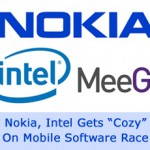 Barcelona, Spain — After three years of dodging questions over why it was so far behind Apple’s iPhone; At the Mobile World Congress in Barcelona, Spain, Microsoft has reappeared from the backseat of the smartphone war to front and center, unveiling an impressively redesigned Windows Phone 7 for the first time, which has been designed from the ground up to seamlessly pull together content from social networking sites and other web services on a scale unseen on competing platforms that will soon become a serious challenger to Apple’s iPhone.
Barcelona, Spain — After three years of dodging questions over why it was so far behind Apple’s iPhone; At the Mobile World Congress in Barcelona, Spain, Microsoft has reappeared from the backseat of the smartphone war to front and center, unveiling an impressively redesigned Windows Phone 7 for the first time, which has been designed from the ground up to seamlessly pull together content from social networking sites and other web services on a scale unseen on competing platforms that will soon become a serious challenger to Apple’s iPhone.
The company said Monday it will withdraw Windows Mobile 6.5 this year and has reemerged from the drawing board with Windows Phone 7 Series, a system that breaks free of the previous PC-centric design.

Microsoft CEO Steve Ballmer explains the new software Monday at the Mobile World Congress in Barcelona, Spain.
“It is all about the phone and how consumers react to the device,” Microsoft’s Ballmer said, opening a news conference held outside the Mobile World Congress in Barcelona on Monday.
The new Windows Phone 7 Series operating system introduced is a depicts a radical overhaul of the aging Windows Mobile platform, and also marks a move by Microsoft to take greater control of the user interface of its phone software.
Earlier Windows Mobile releases were removed to make way for an entirely new design that combines Microsoft’s Zune music player and the Xbox Live gaming service.
“We wanted to apply greater accountability for the end user experience,” Ballmer said. “We want more consistency in the hardware platform and in the user experience,” he said, while nevertheless saying Microsoft wanted to leave room for hardware partners to innovate.

The Windows Phone 7 start screen.
Microsoft also longed for the application to differentiate future phones from its past offerings, both phone and PC.
“Phones appears like PCs, but in effect a phone is not a PC, it is smaller, more personal,” said Joe Belfiore, vice president for Windows Phone.
To make the appearance more personal, Microsoft is betting on a chessboard style of customizable “live tiles” that can update automatically with information from the phone or the Internet.
Some of the tiles will be refreshed automatically to show regular contacts or local information, while others can be customized manually. The tiles will be assembled into themed “hubs,” for example a page of contacts called “people” or a page of photos called “pictures”.
Five Key Hubs:
Windows Phone 7 features a completely new interface, exhibiting what a high-end phone should look and feel like — but the new software is earning Microsoft that most precious commodity among consumer tech companies with a “start” page based around live “tiles” or, in Belfiore’s words, “super icons”. There are five main hubs representing the most common tasks:
- People: Contacts from Outlook, social networking sites and web mail services are pulled, with thumbnail images, into one interface. People the user has frequently communicated with rise to the top and for each contact the phone can display their recent activity on various social networking sites.
- Pictures: All of the photos you have clicked with the phone, synced from a PC or uploaded to social networking sites can also be viewed in a single interface. Photos uploaded by friends to their social media profiles can also be accessed.
- Office: View and edit documents or make voice, text and picture notes.
- Music + Video: Every Windows Phone 7 will essentially be a Zune music player, with users able to sync music and videos using PC software similar to iTunes. Third-party music and video applications such as Pandora are also integrated.
- Games: Xbox Live is built-in and users can play casual games against people on other phones, on PCs or on Xbox consoles.
“We felt that we really had to evolve … we really want to make sure that we are more accountable for the end-user experience,” Microsoft’s general manager for mobile for Asia-Pacific, Natasha Kwan, said in an interview.
Ballmer designated it as a “phone built for people in motion,” the old and the young, straddling the home and the office. “We are starting to embrace the totality of customers’ lives,” he said.
The company said its key priority with the new operating system was maintaining consistency in design. Each Windows Phone 7 device will have three buttons on the front – Start, Search and Back. The tile menu interface will also be virtually the same on all handsets.
The display features an on-screen QWERTY keyboard and will support four-point multi-touch interfaces similar to the way as Windows 7 for PCs. Another characteristic adopted from PCs is the Web browser: it is based on the same code as the desktop version of Internet Explorer, Belfiore said.
Ballmer’s announcement was way in advance of the actual launch. The touch-screen smartphone will not start selling until the holiday season — a long stretch in a swift-moving business — and the company has significant work to do with device makers and wireless carriers.
Microsoft expects the first phones built around the new operating system are set to hit the market by Christmas this year, and says that network operators including Deutsche Telekom, Orange, Verizon and Vodafone, and vendors including Samsung, LG, Sony-Ericsson, Dell, HP, Toshiba and long-time partner HTC have committed to offering devices running Windows Phone 7 Series.
Analysts have commented that this could be Microsoft’s last chance to recapture market share snapped by competitors such as Apple, Google and RIM over the last few years. The iPhone has dominated Windows Mobile in the consumer market, while business users have turned to BlackBerry.
“They are in amongst the losers and getting less and so if they do not do something really drastic they are history in the mobile market,” said Gartner analyst Robin Simpson.


